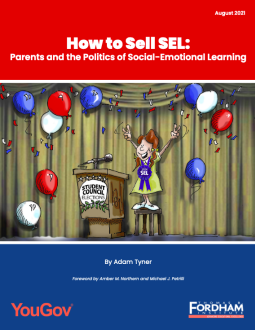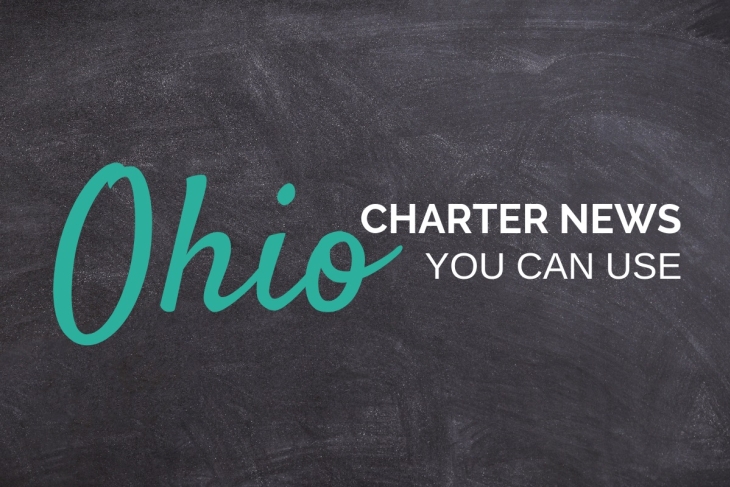- The data from North Carolina schools shows that in-person learning is more effective—and can be safe with masking and vaccination, regardless of community infection rates. —New York Times
- The CDC recommends quarantines for unvaccinated students and school staff, with temporary masking recommendations for vaccinated students exposed to Covid-19. —K12 Dive
- All Ohio school districts’ fall reopening plan have students in-person five days a week, but most also keep masks optional in schools, despite the recommendations of health experts and the CDC. —Dayton Daily News
- “Researchers are developing artificial intelligence aimed at keeping students engaged and saving educators’ time.” —WSJ
- More than 1 million children didn’t enroll in local schools because of the pandemic, many of them kindergarteners from low-income families. And for many, the choice stemmed from frustration with what schools were delivering during the closures. —New York Times
How to Sell SEL: Parents and the Politics of Social-Emotional Learning
This report examines parents’ opinions on SEL and pitfalls in communicating about it. It finds overwhelming support for the essence of SEL and its place in schools, but differences by political party and challenges in getting the terminology right.
- I have to admit I didn’t realize just how venerable (for lack of a better word) those schools-specific public transit routes for Cincinnati City Schools students were—in use for more than 40 years—which explains to my satisfaction why district officials were so incensed when they learned that those routes were discontinued “suddenly”. While the accuracy of that descriptor still seems to be in question, what’s not in question is that so-called XTRA routes will not be reinstated for this school year—a fact reinforced by the boards of both the district and the transit authority after a big summit meeting yesterday. The two agencies will, however, work together over the next week or so to make tweaks to SORTA’s new plans for students riding regular commuter routes, if any such tweaks are needed. (WCPO-TV, Cincinnati, 8/10/21)
- Meanwhile, in other breaking news, the fellow tapped to replace outgoing state supe Paolo DeMaria in September has himself submitted his resignation from ODE, effective on the same day. Says he’s got a “unique opportunity to lead a small, nonprofit organization located in Stark County that works to connect education, business and the community.” Wonder which one that could be? (Dayton Daily News, 8/10/21)
- We should probably talk summer school (or whatever we’re allowed to call it today) while summer is still with (some of) us. The bulk of this piece is about the nonsensical (to this M.C.R.P. degree-holder) notion of a school district needing to exercise eminent domain on a city government to acquire some empty land, but there is a tiny little summer school nugget toward the bottom: Canton City Schools administrators reported to the elected school board this week that their “summer learning program attracted roughly 650 students, including nearly 260 high school students who collectively earned 300 class credits that they needed to graduate.” That’s supposed to be a “yay!” moment, right? Just askin’. (Canton Repository, 8/9/21) Here’s a look at some cool-sounding science projects being provided for kids by Cleveland teachers during weekend community events in a local park. While we hear briefly and tangentially that “[t]he most intense science and math lessons this summer happened at the district’s five-day-a-week summer learning program,” we also hear that, “[t]eaching any science to kids is a big need for Cleveland schools, even before COVID kept students out of classrooms, relegated to online learning for more than a year. Cleveland scores near the bottom of Ohio school districts on state fifth and eighth grade science tests.” Any. Science. So, again, I gotta ask whether I’m supposed to be “yay”ing this or not. (The 74, 8/10/21)
- And speaking of online learning, here’s a national story with a Columbus, Ohio, dateline regarding what are termed long-term changes in the direction of training for future teachers. It includes the understatement of the century: “Nobody's hurt by additional information about teaching online.” That is, the understatement of the 20th century. (AP, Via U.S. News & World Report, 8/10/21)
- Speaking of understatements, Lt. Governor Jon Husted this week told a gathering of officials and business folks in Mansfield, “You'd be surprised at the number of students who are neither getting a career credential or not being prepared for college and who are graduating unprepared for life.” He touted many state initiatives specifically around career, technical, job skills education but stressed that quality K-12 education must come first. “That means ensuring children can read by third grade, do simple math by sixth grade,” he said, “and be ready for a career or college education upon graduation.” Nice. (Bucyrus Telegraph Forum, 8/11/21)
- Probably coincidentally, the editorial board of the Morning Journal eloquently echoed the Lt. Governor when opining on new school report cards: “We rate schools for the same reason we rate student performance — to ensure they are meeting performance standards. When schools don’t live up to expectations, we should concentrate more on finding the flaws and improving how we educate, and less about analyzing whether there is a better way to rank the schools. If the rating system is working, successful schools and districts will rise to the top, whether rated with letter grades or numbers of stars. At the end of the day, the evaluation system is far less important than the fact that there is a clear benchmark with fair and measurable standards. No matter what the system, the goal always must be to help our young people gain the knowledge and skills that they will carry into adulthood.” To which your humble clips compiler adds an uncharacteristic “Hear, hear!” (Morning Journal, 8/10/21)
Did you know you can have every edition of Gadfly Bites sent directly to your Inbox? Subscribe by clicking here.
This report examines parents’ opinions on SEL and pitfalls in communicating about it. It finds overwhelming support for the essence of SEL and its place in schools, but differences by political party and challenges in getting the terminology right.
The vast majority of Ohio teachers are paid according to salary schedules that reward seniority and degrees earned, the result of state laws that require school districts to follow this rigid compensation scheme. Unfortunately, this method fails to acknowledge other factors that legitimately should influence teachers’ wages, including their classroom effectiveness, professional responsibilities, or demand for their labor.
But what if these constraints were loosened, so that school leaders could pay teachers in a more flexible way? A recent study by Yale University’s Barbara Biasi looks at what happened in Wisconsin after lawmakers passed reforms via Act 10 in 2011 that allowed districts to ditch the traditional salary schedule and adopt flexible pay policies. Roughly half of Wisconsin’s districts leveraged these new autonomies to negotiate salaries with each employee, much like many businesses do. The other half maintained a traditional seniority- and credentials-based salary schedule that applied to all teachers.
Her analysis reveals several eye-opening findings about the Wisconsin districts that switched to a flexible pay structure. These districts:
- Offered higher salaries to early career teachers. To give an example, Green Bay—a flexible pay district, post Act 10—paid teachers with less than five years of experience anywhere between $42,000 and $55,000 per year. In contrast, Madison, a district that stuck with a traditional salary schedule, set salaries for less experienced teachers within a narrower range of around $38,000 to $45,000. The higher salary ceiling in flexible pay districts allowed them to attract talented early career teachers (see next point).
- Attracted high-performing teachers, especially younger ones. Flexible pay districts drew teachers with significantly higher value-added scores, especially among those with less experience. The same was not true for traditional pay districts. They didn’t experience an influx of highly effective teachers. The analysis also indicates that teachers with lower value-added scores were more likely to exit flexible pay districts. Due to these entrances and exits, flexible pay districts saw an increase in the overall quality of their instructional staff.
- Rewarded instructional quality. In flexible pay districts, a one standard deviation increase in teachers’ value-added scores was associated with a 0.4 to 0.7 percent higher salary. No such correlation between wages and value-added existed among traditional pay districts. Even though Wisconsin districts didn’t receive value-added scores during this time period—those were calculated by the author—they were still able to identify quality teachers and modestly boost their pay.
- Increased performance among all teachers in the district. In addition to improvements linked to teacher mobility, the new compensation structure incentivized higher performance among all educators in the district. After the switch to flexible pay, the average value-added score of teachers in flexible pay districts rose more rapidly than in traditional pay districts. The prospect of higher wages under a system that rewards performance and effort, rather than longevity, could explain those results.
- Moved the needle on student achievement. Given all this, it’s not surprising to see students reaping the benefits. In Wisconsin’s flexible pay districts, student achievement on state exams rose by 0.06 and 0.05 standard deviations in reading and math, respectively—which, according to the author, is equivalent to about one-third of the effect of class size reductions. In traditional pay districts, however, achievement was flat. The bottom line, as Biasi puts it: “These tests indicate that changes in the composition and effort of teachers in flexible pay districts following the change in pay schemes led to a sizable increase in students’ test scores.”
Unlike Wisconsin, Ohio still prevents district leaders from experimenting with different compensation strategies. Even if they want to adjust salaries to attract and retain talented teachers or fill hard-to-staff positions, they remain locked into structures that reward seniority and credentials. Yes, the politics of reform will be difficult to navigate for Ohio lawmakers. But the evidence, not to mention commonsense, points to giving schools more autonomy and flexibility in determining teacher pay. Some districts may stick with what they know—the single salary schedule—but as the Wisconsin example shows, others will use their newfound discretion to gain an edge in the labor market and drive higher student learning. Why stand in their way?
- The new school year is starting up in an increasing number of schools and districts around Ohio. Thus it is a perfect time for Ohio Excels president Lisa Gray to opine positively on the changes to state report cards which will be in place for the first time this year. (Columbus Dispatch, 8/9/21)
- The heads of the Dayton and Ohio teachers unions are also gearing up for the new school year, although they seem a little less certain about their stuff than Lisa Gray does about hers. This piece is only 350 words long, yet discussion of kids getting on academic track after two school years’ worth of disruption goes from “ensure” to “plan to” to “hopefully” really fast. Personally, I’m hopeful that the new report card can tell us which one it ultimately turns out to be. (WDTN-TV, Dayton, 8/6/21)
- Let’s not forget, though, that in-person school requires kids to actually get to those buildings and that acquiring adequate transportation to and from those buildings—especially for students utilizing a non-district choice—is often a tricky proposition for families. Here’s a first look at how changes to the “payment in lieu of transportation” rules, as enacted in the new state budget, will affect some districts. Spoiler alert: It’ll hit ‘em in their bottom line. And if we’ve learned anything from years and years of this Gadfly Bites lark, it’s that district officials and elected board members really hate it when that happens. Although the discussion of one specific student case in Twinsburg is interesting—and kudos to the ABJ for at least including it here—district finances are the main concern of this piece. Shocker. (Akron Beacon Journal, 8/9/21)
Did you know you can have every edition of Gadfly Bites sent directly to your Inbox? Subscribe by clicking here.
The end of suburban “opportunity hoarding”?
Ohio’s recently-enacted biennial budget took the important step of eliminating the geographic restrictions on where charter schools can locate. RedefinED’s Matthew Ladner suggests that is just one of a number of factors that will increase accessibility to quality school choice options for Ohio students.
“The miracle of our work”
A blog published by The Times of Israel features a detailed interview with Breakthrough Schools CEO Alan Rosskamm. It looks at his life and early career, the philosophy of the Breakthrough model, how his schools navigated two years of Covid-disrupted learning, and more.
Spending federal Covid relief funds
The Dayton Daily News this week checked in with a number of schools and districts in the Miami Valley area to see how they are planning to spend millions in federal Covid relief funding. That includes the National Heritage Academies network of charter schools.
More Covid support resources available
The U.S. Department of Education recently released a new resource to guide schools and districts in spending federal relief dollars to improve ventilation and mitigate the spread of Covid-19. Suggested uses of funds include HVAC system repair and maintenance, air filtering and purification, and even window and door repairs. You can access the guide here.
Event video available
The Progressive Policy Institute (PPI) and The 74 co-hosted a virtual event earlier this week titled “The Future of School Choice.” Participants included former Georgia State Rep. Alisha Thomas Morgan; Dr. Charles Cole, founder of Energy Convertors; Naomi Shelton, CEO of the National Charter Collaborative; Jada Bolar, executive producer of the National Parents Union; and Patrick Jones, senior vice president of The Mind Trust. Curtis Valentine, co-director of PPI’s Reinventing America’s Schools Project, moderated the discussion. If you missed this important event, the video is available to view here.
*****
Did you know you can have every edition of the Ohio Charter News Weekly sent directly to your Inbox? Subscribe by clicking here.
- RedefinED’s Matthew Ladner posits that a number of factors—including an ongoing baby bust, that crazy little thing called ‘rona, and the recent removal of restrictions on where charter schools can locate—will combine to accelerate utilization of school choice in Ohio and hasten the end of what he terms “suburban opportunity hoarding”. From his mouth to parents’ ears, amiright? (RedefinED, 8/6/21) I can’t help but think of Ladner’s analysis as I read this story about suburban Springfield Local Schools’ enrollment team setting up shop at apartment complexes around the area to recruit new families into the district. Oh, I know the piece doesn’t use the word “recruit”, but that is what it would be called if a charter or private school set up a tent in the same lot for the same purpose. Even if those charter school staffers used the exact same “we’re just here to help busy parents and support students” language as quoted. Now wouldn’t it? (WTOL-TV, Toledo, 8/5/21)
- Last week, we briefly discussed the transportation situation in Cincinnati City Schools, which underwent an upheaval—said to be a “surprise” to the district and the subject of investigation and accusation already—just a couple of weeks before the start of the new school year. And while this is just one thing on the mind of the local teachers union boss, she opines strongly against the busing route changes being wrought. (Cincinnati Enquirer, 8/4/21) I find it hard to believe that the school district really loved using public transit for student transportation to the extent demonstrated in the editorial pages of the Enquirer. But it must be true. How else to explain this letter from the district’s elected school board which commands the transit authority to restore those cancelled routes immediately, raising the specter of “kids in danger” multiple times in the process? (Cincinnati Enquirer, 8/5/21) Meanwhile, leadership of the Southwest Ohio Regional Transit Authority (SORTA) is busy trying to explain not only why the new routes are better (faster, more frequent, more flexible) but that even if they are not always better, they won’t be any worse than the cancelled ones (which were apparently frequently non-existent last year due to bus driver shortages that, it seems, have not yet been fully alleviated). And of course SORTA has to rebut the “surprise announcement” and “kids in danger” narratives as well. To which I say: good luck with that. (WCPO-TV, Cincinnati, 8/5/21)
- Meanwhile, out in the Cincinnati ‘burbs: Lakota Local School students are getting laptops like it’s 2020. Or indeed 2010. Hoarding? What hoarding? (The Journal News, 8/4/21)
Did you know you can have every edition of Gadfly Bites sent directly to your Inbox? Subscribe by clicking here.
I’ve long believed the best argument for school choice is to turn up the lights on what is possible when there’s room for a wide variety of schools, curricula, and cultures. Call it the When Harry Met Sally model. Create schools that are so compelling and attractive, and with such great results for kids, that parents look at it and say, like the character in the movie’s famous diner scene, “I’ll have what she’s having.”
Perhaps it’s a function of our angry and divisive times, but lately the proponents seem determined to argue not the positive attributes of choice and the full range of options it makes feasible, but the role of choice to allow families to avoid exposing kids to ideas and curricular content parents don’t like. This version of choice feels lifted not from a heart-warming rom-com, but from a mob movie: “You've got a nice family. It'd be a shame if anything were to happen to ‘em.” Or worse, a prison-break movie like Escape from Alcatraz or Cool Hand Luke.
What we’ve got here is a failure to communicate the positive benefits of choice.
I’m an enthusiastic school choice proponent, but I will confess to disappointment with advocates whose arguments about the advantages of choice rest entirely on conflict avoidance, and whose pitch is not the positive virtue of what it allows families to enjoy, but the negative virtue of what it allows them to avoid, most particularly critical race theory and pedagogies and practices informed by it in traditional public schools.
For many years, the Cato Institute has done essential work collecting and cataloguing hundreds of examples of school and district curriculum and culture fights, compiling them into a “public schooling battle map,” sortable by categories: race and religion, curriculum, moral values, gender equity, sexuality, etc. “Rather than build bridges,” Cato notes, “public schooling often forces people into wrenching, zero‐sum conflict.” That may be true, but when your primary argument for choice is simply to avoid fights, you’re just retreating to your side of the river and hoping the other guy stays on his. That’s not building bridges either.
To be sure, public schooling’s ability to nurture fellow feeling is overrated. But school choice as a peace-for-our-time solution elides a few basic truths. Changing schools is not like switching grocery stores. In most cases, it’s deeply disruptive to the lives and routines of an entire family. It’s not a decision made lightly or because you don’t like an assigned text or homework assignment. Positioning choice as an off-ramp to escape conflict undersells these challenges. Moreover, while Americans have long taken a dim view of public education at large, they historically give their own kids’ schools high marks (although even stalwart public school parents have begun questioning their loyalties as Covid-related disruptions threaten a third school year). Parents are reflexively defensive of their kids’ schools and punish those who sow discontent, much as they fight those who would alter or close their schools. Recall the well-earned beating Arne Duncan took when he attributed opposition to Common Core to “white suburban moms” who were miffed to learn that “their school isn’t quite as good as they thought they were.”
Most pertinently, school-choice-as-conflict-avoidance makes a virtue of disengagement from uncomfortable but critical debates in which choice advocates have a major stake. Your ability to exercise choice and personal liberty depends in no small measure on your fellow citizens’ shared enthusiasm for it. It behooves you to insist on respect for personal liberty and to ensure that tolerance of divergent views continues to flourish and grow—even in the schools you do not send your child to. This point seems entirely lost upon choice advocates who view schools teaching “the same civic and cultural values” as a problem. Safeguarding your right to raise your children in accordance with your views is one of those civic and cultural values. It needs some care and cultivation. It cannot be taken for granted.
Without question, we’re in a moment right now that lends itself to taking advantage of disruption and discontent with schools, whether over Covid-related interruptions to in-person instruction, mask mandates, or fights over critical race theory in schools. It’s no coincidence that legislation expanding school choice is on the march, with measures to offer or expand choice options gaining traction in dozens of states. It would be foolish for advocates not to feed the growing appetite for school choice
But eventually the pandemic will end. Even the most devoted “culture war” combatants will exhaust themselves and move on to other issues. The ability to free children from violence and bullying or to leave a hopelessly failing school is essential and deserves to be fiercely defended. But it’s morally unsatisfying to depend entirely or mostly on parental discontent to create an appetite for choice. It suggests an impoverished vision of education and a lack of appreciation for the dynamism and variety choice could bring to families. Worse, it’s self-defeating. “Your kid’s school sucks, demand choice” is a less compelling and more divisive pitch than, “your kid’s school is fine, but would you prefer a classical curriculum? Maybe a tech-focused school or project-based learning? How about a school that reflects your child’s interests and affirms your family’s values?”
There’s a perverse irony in promoting choice mostly as a way to avoid conflict. It creates a kind of crocodile tears advocacy: It depends on the thing you insist you want to avoid to create the conditions needed to drive demand. When that conflict isn’t in evidence or evaporates, so does your argument for choice.
On June 4, the U.S. Department of Education’s Office for Civil Rights asked for information that would help it “support schools in addressing disparities and eliminating discrimination in school discipline and fostering positive and inclusive school climates,” suggesting that something resembling the Obama-era discipline guidance may be reinstated in the near future.
This article, which is based on my response to the Request For Information (RFI), addresses the four questions that are at the heart of the discipline debate, as I understand it: What factors explain racial discipline disparities? What are the likely consequences of exclusionary discipline? What are the likely consequences of another unfunded discipline mandate? And how can we reduce racial disparities in discipline without imperiling disadvantaged students’ right to an education?
What factors explain racial discipline disparities?
As the department’s RFI notes, “in 2017–18, Black students represented only 15 percent of the total student enrollment but accounted for 29 percent of all students referred to law enforcement—almost twice their share of overall student enrollment.” This disproportionality, it is assumed, is due mostly to racial bias. But what the RFI does not note is that 15 percent of Black students in grades 9–12 report having been involved in a physical fight on school property—almost twice the 8 percent rate reported by all students.
Similarly, the RFI mentions that Black students represent 36 percent of expulsions and 38 percent of students who received one or more out-of-school suspensions (OSS)—roughly two-and-a half times their share of overall student enrollment. However, it does not mention that principals of schools where minority enrollment exceeded 75 percent were four times as likely to report that “verbal abuse of teachers” was a weekly occurrence as those in schools where minority enrollment was less than 25 percent.
Teachers’ accounts corroborate those of principals and students. To wit, a recent Fordham study found that teachers in high-poverty schools were two and a half times more likely to report that verbal disrespect was a daily occurrence, six times more likely to report that physical fighting was a daily or weekly occurrence, and three times more likely to report having been personally assaulted by a student. (Importantly, Black and White teachers in these schools reported similar rates of student misbehavior.)
Balanced against this overwhelming evidence are one study that found that exposure to Black teachers reduces Black students’ odds of suspension, and several studies that find that Black students receive more severe punishments than White students who commit similar infractions. Yet the magnitude of these effects is small relative to disciplinary disparities. Thus, the primary explanation for those disparities—according to principals, teachers, and students themselves—seems to be differences in student behavior, which isn’t surprising given the risk factors that are correlated with student race.
What are the likely consequences of exclusionary discipline?
While numerous studies have linked exclusionary discipline to negative outcomes for students, most have relied on inherently problematic comparisons between students whose behavioral infractions were deemed suspension-worthy and “otherwise similar” students who weren’t suspended. Exceptions to this rule find smaller effects—at least for academic outcomes. Meanwhile, a substantial body of research suggests that disruptive students impose large costs on their peers, suggesting that suspensions have significant benefits for non-suspended peers’ academic achievement. For example, one recent study found that non-suspended students gained the equivalent of several days of math learning when a student in their class was suspended for a serious incident.
That finding is consistent with teachers’ views. For example, overwhelming majorities of teachers in Fordham’s discipline survey agreed that out-of-school suspension was useful for “removing disruptive students so that others can learn,” as well as “sending messages to parents about the seriousness of infractions” and encouraging both suspended students and their peers to follow the rules. Overall, only a quarter of teachers agreed that “the negative impacts of OSS outweighed any possible benefits.”
On strictly academic grounds, it’s likely that suspensions pencil out. But the elephant in the room is criminal justice involvement—an outcome where teachers may be no wiser than the rest of us. Here, again, causal evidence is hard to come by, but a recent study that uses changes in attendance zones to examine the effects of “strict” schools should give discipline hawks pause.
According to the researchers:
Students assigned a school with a 1 standard deviation higher suspension effect are 2.6 percentage points more likely to have ever been arrested and 2.1 percentage points more likely to have ever been incarcerated, increases of 14 percent and 17 percent, respectively.
Like all the other numbers in the discipline debate, those numbers aren’t written in stone. But for the sake of argument, suppose that you could boost ninety-eight Black students’ achievement by the equivalent of one week—no wait, let’s make it a month—of learning, at the cost of sending two more Black boys to jail.
Would you make that trade?
If you’re not sure, my strong advice is to keep an open mind and not get too attached to the notion that suspensions are obviously good or bad.
What are the likely consequences of another unfunded discipline mandate?
The simplest way to eliminate racial disparities in school discipline is to equalize suspension rates or other forms of exclusionary discipline by fiat. Yet one study of the academic impact of banning suspensions for “willful defiance” in California found that the impact on math performance in grades four through seven was equivalent to moving from the 50th percentile to the 39th percentile. Similarly, a study of Philadelphia’s ban on OSS for disorderly behavior found that non-suspended peers’ math achievement and attendance declined in schools that didn’t—or perhaps couldn’t—fully implement the policy.
In theory, implementing “alternatives to suspension” such as restorative justice and Positive Behavior Interventions and Supports (PBIS) could reduce the costs disruptive students impose on non-suspended peers. Yet in reality, the only experimental evaluation of “restorative justice” found a negative effect on math achievement in majority-Black schools. And, in practice, the costs of mandating that students who misbehave remain in the classroom or school are probably larger than the costs of retaining them voluntarily (e.g., if a teacher’s authority is visibly undermined by his or her inability to impose meaningful consequences).
To be fair, there is some evidence that PBIS can improve school culture at the elementary level. Still, there’s no evidence that this is possible in higher grade levels, and the aforementioned results don’t necessarily generalize to elementary schools that are forced to reduce their suspension rates.
Notably, three quarters of teachers in Fordham’s discipline survey reported that “higher tolerance for misbehavior” was at least partly responsible for the decline in OSS at their school. Moreover, nearly one in five believed that underreporting was “mostly” or “completely” responsible for that decline—consistent with reports of widespread underreporting in Broward, Detroit, Louisville, Memphis, Philadelphia, and the District of Columbia. In another Fordham analysis, revisions to the Philadelphia school district’s code of conduct that limited suspensions for minor offenses were associated with an increase in racial disproportionality, in part because of a suspicious increase in more serious offenses.
How can we reduce racial disparities in discipline without imperiling disadvantaged students’ right to an education?
Corporal punishment should be banned. Suspensions for improper “grooming” or poor attendance have rightly been criticized. And there is a clear case for limiting the use of OSS for low-level infractions in the early grades, where research and common sense suggest the unintended consequences are manageable.
Still, as the grade level increases, the assumption that schools can handle whatever behavior students exhibit without imposing significant costs on other students becomes less tenable. Consequently, the safest approach to addressing concerns about criminal justice involvement in higher grades is to ensure that alternative environments within the school are a viable option for the chronically disruptive or violent students who need them.
Nationally, perhaps four-fifths of schools use in-school suspension (ISS), two in five use a “de-escalation room” where students can cool off before returning to class, and one-third have a more permanent alternative learning center (ALC) for persistently disruptive students. Yet the quality and capacity of these environments varies. For example, many Philadelphia teachers reported that lack of staffing and space were key barriers to the implementation of its reforms, with the result that many teachers continued to rely on OSS.
Given the attendance challenges low-income students have faced during Covid-19, ensuring that schools with high-suspension rates have the resources to keep more students in the school building voluntarily would be a logical use of the $189 billion in additional funding that schools received in Elementary and Secondary Schools Emergency Relief (ESSER). But even in normal circumstances, implying that educators are racially biased is a poor substitute for giving them the resources they need to serve students effectively.
That, of course, is a much heavier lift, which is what makes the whole debate so frustrating, circular—and a bit repetitive.








